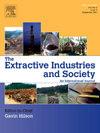Sustainable copper supply chains: Evaluating ESG risks through the lens of regulatory compliance and risk assessment strategies
IF 3.6
2区 社会学
Q2 ENVIRONMENTAL STUDIES
Extractive Industries and Society-An International Journal
Pub Date : 2025-04-12
DOI:10.1016/j.exis.2025.101662
引用次数: 0
Abstract
The global demand for copper is projected to increase by approximately 3.5 times by 2050, yet the mining industry faces significant challenges in meeting this demand due to inherent risks within the copper supply chain. The industry's ability to address the supply chain risks will largely depend on its capacity to manage Environmental, Social, and Governance (ESG) issues. Leveraging current technology and real-time data collection is crucial for efficiently and effectively mitigating ESG risks, as it enables prompt identification and response to potential issues. However, the absence of standardized metrics for ESG compliance presents a critical barrier. This study aims to develop a retrospective and qualitative assessment to evaluate ESG risks in the copper supply chain through a regulatory compliance lens and apply risk assessment strategies across different stages of the supply chain. Our findings indicate that while local, national, and international regulations, rights, and guidelines are extensive, effective application and adherence to these standards can significantly reduce ESG risks. We conclude that regional governments should play a leading role in establishing a robust ESG framework with accountability and transparency to support sustainable copper supply chains and ensure the industry's future viability. We recommend the integration of data-driven technologies in ESG assessment and compliance.
求助全文
约1分钟内获得全文
求助全文
来源期刊

Extractive Industries and Society-An International Journal
ENVIRONMENTAL STUDIES-
CiteScore
6.60
自引率
19.40%
发文量
135
 求助内容:
求助内容: 应助结果提醒方式:
应助结果提醒方式:


